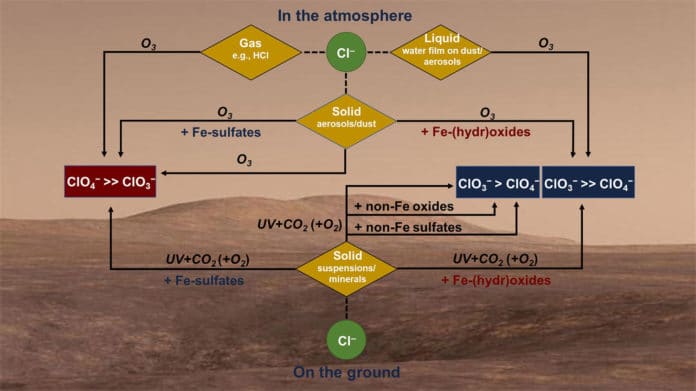Perchlorate (ClO4−) and possibly chlorate(ClO3−) are ubiquitous on Mars. Their abundance ratio has critical implications for the redox conditions, aqueous environments, and habitability on Mars. However, factors that control the generation ratios of Chlorate and Perchlorate on Mars are not well established.
Years of observations by Mars landers and rovers suggest that oxychloride species (Clix-) are ubiquitous on the Martian surface. Determining their effects is essential for the chlorine cycle at the soil-atmosphere interface on Mars, exploration of organics on Mars, hazard assessment of future human exploration, and in situ resource utilization.
A research group led by Dr. ZHAO Yuyan from the Institute of Geochemistry of the Chinese Academy of Sciences (IGCAS) evaluated how the iron mineralogy, oxidants, oxidation pathways, and presence of liquid water would influence the generation ratios of ClO4-/ClO3- on Mars.
Scientists found that iron mineralogy is the presiding factor controlling the ClO4-/ClO3- generation ratio: the Fe sulfates and Fe3+-montmorillonite mixing with NaCl produce much higher yields ClO4- than of ClO3-, whereas the opposite is true for the NaCl-Fe (hydr)oxide mixtures.
The study also indicates that the physical state of chloride and the characteristics of the co-occurring minerals have the most significant influence. The oxidation sources and atmospheric composition were found to have secondary effects.
It should be noted that the generation ratios of Chlorate and Perchlorate in different surficial environments are relevant to Mars.
Scientists noted, “During the Noachian and Hesperian, when phyllosilicates and sulfates predominated, fluid activities were widely distributed, and UV radiation was relatively faint, Clix- production would have been less efficient than in later geological periods. The aqueous environments may produce more ClO3- than ClO4-, but some local regions dominated by Fe sulfate evaporites may produce much more ClO4- than ClO3-.”
“Since the Amazonian, when a (hyper)arid climate prevailed with stronger UV irradiation and ubiquitous Fe (hydr)oxides and other oxides, Clix- yields higher by orders of magnitude would have been produced with much more ClO3- than ClO4-.”
Journal Reference:
- Qu, SY., Zhao, YY.S., Cui, H. et al. Preferential Formation of Chlorate over Perchlorate on Mars Controlled by Iron Mineralogy. Nat Astron (2022). DOI: 10.1038/s41550-021-01588-6
